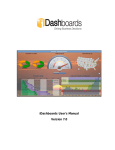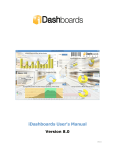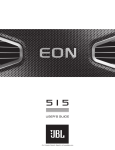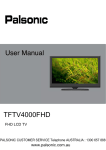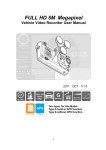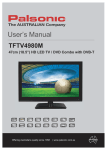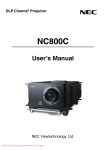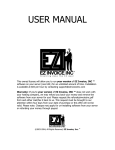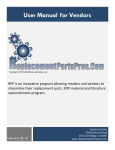Download User`s Manual in English
Transcript
User’s Manual in English English Version R02 Aug 2008 Trademarks All brand and product names are trademarks or registered trademarks of their respective companies. Note The information in this manual is subject to change without notice. Before You Start ※ Precautions and Notices ※ For your own safety, do not operate the controls of the product while driving. ※ Use this product prudently. The product is intended to be used only as a navigation aid. It is not for precise measurement of direction, distance, location or topography. ※ The calculated route is for reference only. It is the user’s responsibility to follow the traffic signs and local regulations along the roads. ※ When you get off the car, do not leave your device on the dashboard that is subject to direct sunlight. The overheating of the battery can cause malfunction and/or danger. ※ GPS is operated by the United States government, which is solely responsible for the performance of GPS. Any change to the GPS system can affect the accuracy of all GPS equipments. ※ GPS satellite signals cannot pass through solid materials (except glass). When you are inside a tunnel or building, GPS positioning is not available. ※ A minimum of 4 GPS satellite signals is needed to determine current GPS position. Signal reception can be affected by situations such as bad weather or dense overhead obstacles (e.g. trees and tall buildings). ※ The wireless devices might interfere the reception of satellite signals and cause the reception of the signal to be unstable. For better signal reception, it is recommended that you use a car antenna (option). ※ A car holder is needed when using the device in a car. It is recommended that you place the device in an appropriate place, so as not to obstruct the driver’s view, or deployment of airbags. ※ When battery run out, the device will automatically turn off the power. So, when plug-in the car charger or power adaptor, please reset the ON/OFF switch to re-initiate the device. 1 ※ Overview GPS Navigation Features ※ Electronic maps with roads, freeways, highways, railways, rivers, lakes, points of interest, etc. ※ GPS positioning ※ Optimal route calculation and trip plan ※ Friendly and efficient navigation with turn-by-turn, voice, and visual guidance ※ Various ways for searching a location on the map - Using a known address - Using a POI (point of interest) - Using Favorites (personal stored locations) - Using History (previous destinations) ※ Recording and playback of journeys ※ Viewing modes for different needs and situations: - 2D or 3D - Daytime or nighttime view - Turn-by-turn view of the route - Driving direction of the route 2 Other Features ※ Audio Player ※ Photo Viewer ※ Movie Player About this Manual This manual is divided into four major parts: ※ Part I “Basic Operations” tells you how to get your device running and customize system settings. ※ Part II “Media” introduces Music Player, Photo Viewer, Video Player.,etc. ※ Part III “ Hands Free Calling” ※ How to use the navigation? Please see Navigation Manual attached to the package and CD. 3 Part I. Basic Operations Part I guides you through the process of getting your device running, familiarizes you with the external components, and tells you how to customize system settings 4 1. Getting Start This chapter tells you step by step how to perform the initial startup and introduces you to the external components of your device. 1.1 Setting the ON/OFF Switch It is strongly recommended that charge your GPS device completely before use it at first time. USB Connector 5 1.2 Connecting to AC Power and Charging the Battery Connect the adapter cable to your device and plug the AC adapter (optional) into a wall outlet. When charging the battery for the first time, you should charge it for at least 8 hours. NOTE: ● Depending on your region of purchase, the connector converter may not look exactly the same as the picture shown. ● The charge indicator glows amber when charging is in progress. Do not disconnect your device from AC power until the battery is fully charged, when the charge indicator turns green. This will take a couple of hours. z .If you will not use the product for a long period of time, be sure to fully charge the battery at least once every two weeks. Over discharge of the battery can affect the charging performance. 6 1.3 Using Your Device in a Vehicle Using the Car Holder ※CAUTION: 1. Select an appropriate location for the car holder. Never place the holder where the driver’s field of vision is blocked. 2. If the car’s windshield is tinted with a reflective coating, an external antenna (optional) may be needed to route the antenna to the top of the car through a window. When closing the car window, be careful not to pinch the antenna cable. (Cars with an anti-jam window design may automatically leave adequate space as needed.) NOTE: Depending upon the specific model purchased, the car holder supplied with your device may not look exactly the same as the picture shown. Notes for Use in a Vehicle ● Take care that the holder does not present any risk to safety, even in the case of an accident, when installing it. ● Take care that the cable does not impede any safety components. ● The display of your navigation system may show “light re-flexions”. Please take care of not being “blinded” during operation. ● Do not mount the components within the operating range of any airbags. ● Check the secure adherence of the suction cup at regular intervals. ● The power plug will consume power, even if no device is connected. Remove it when not in use to avoid draining the battery. 7 ● Check all safety equipment in your car after installation. Connecting the Car Charger The car charger supplies power to your device when you are using the device in a car. ※CAUTION : To protect your device against sudden surges in current, connect the car charger only after the car engine has been started. 1. Connect one end of the car charger to the power connector of your device. 2. Connect the other end to the cigarette lighter in the car to power and charge your device and ensure that it will not lose contact while driving. This could cause a malfunction. ● Hint: Remove the power adapter from the cigarette lighter socket when ending a trip or when parking the car for an extended period of time. 8 Install rear vision system Step 1.Install the camera in the car tail in proper position. Step 2. Put the cable connect positive and negative ports in tail light (Put red cable in positive port; black cable in negative port). Step 3. Put the cable in the correct position in car interior, fix the signal transmitter in the proper position, then connect camera and signal transmitter cable Step 4. Put the cradle and GPS device together and fix in the appropriate location without blocking driver’s vision. Then the rear vision system can be used when driver is parking. 9 Rear vision system signal transmitter Traffic Massage Channel (TMC) S320T can provide you with ideal routes if Traffic Message Channel information is available. The TMC is a specific application broadcasts real-time traffic and weather information via radio data system. Note: TMC is not a global service. It may not be available in your country or region. Please ask your local dealer for the details. Please attach TMC receiver cradle to the GPS device and connect TMC antenna to the TMC jack to receive TMC information. (The TMC antenna may be different by varied configurations.) If TMC data is broadcast at your region, the map will automatically take into account the TMC information received. You do not need to set up any thing in 10 any system. The TMC receiver will search radio station for TMC data automatically. Then you can see the latest information by tapping TMC icon shows in map system. 11 1.4 Understanding Hardware Features NOTE: Depending upon the specific model purchased, the color of your device may not exactly match the device shown in this manual. Ref 1 Component Charge Indicator Description Red indicates that the battery is charging, and turns into green when the battery is fully charged. 2 Main Menu Back to the main menu. 3 Power Button Turns on and off the device. 4 External GPS Antenna Connector This connector allows use of an optional external antenna with magnetic mount, which may be positioned on top of the car for better signal reception in areas with poor reception. 5 GPS Antenna Use to receive satellite signal 6 Speaker Sends out music, sounds and voice 7 Connector Connect to the cradle 8 Headphone Connects to stereo headphones. Connector 9 Mini-USB Connector Connects to the USB cable. 10 Reset Button Restart system 11 SD/MMC Slot Accepts a SD(Secure Digital)or MMC ( Multimedia Card) card for accessing data such as music and movie. 12 2. Setting This chapter guides you through the process of using your device and familiarizes you with the basic operations such as using the stylus pen and navigation pad. 2.1 Turning on Your Device 1. Insert the supplied SD card (optional) into the slot at the bottom of device. 2. Push the System Power button, the device will open, if push the button again, the device will off. (Suggestion: It will display the interface you were off last time.) 3. The Main Menu appears as shown below. You can now use your device. 13 For the Navigation please see Navigation Manual attached to the package and CD. When you press the power button at the top of advice to turn off the unit, your device actually enters a suspend state and the system stops operating. Once you turn on the system again, it resumes. ※ Fully charge the battery before using your device for the first time is recommended. 2.2 System Setting Your device is supplied with default settings. You may customize the settings to suit your personal needs. Once you change settings, your new settings will remain until either you change them again, or until battery cut off switch is turned off and then back on again, which resets the unit to factory defaults. Inserting a SD/MMC Card Your device has a SD/MMC slot where you can insert an optional Secure Digital or Multi Media Card storage card. To use a SD/MMC card, insert it into the slot, with the connector pointing to the slot and its label facing the front of the device. To remove a card, first make sure that no application is accessing the card, then slightly push the top edge of the card to release it and pull it out of the slot. 14 Using System Settings Tap the System button on the Main screen. To open the Settings menu, first tap the Settings button shown as below: 2.2.1. Language Tap arrow to select the language you want. 15 2.2.2 Time& Date 1. Tap theDate/Time button on the Device Settings menu. The Date/Time Function menu appears as shown below. 2. Tap the date button to enter into the date menu. 3. Tap the time button to enter into the time menu. 16 2.2.3 Volume Tap the Audio button on the Device Settings menu. The volume Function menu appears as shown below. Tap [-] and[+] to adjust the volume. To decrease the volume, tap[-]. To increase the volume, tap[+] 2.2.4 Backlight 1. Tap the Backlight button on the Device Settings menu. The backlight Function menu appears as shown below 2. Tap [-] and [+] to adjust the volume. To decrease the volume, tap[-].To increase the volume, tap [+]. 17 2.2.5 System Information Factory Reset Return to the default setting GPS Reset Reset the GPS receiver Calibration You can calibrate the touch screen if it is not responding accurately to your Taps. 1. Tap the About buttonon the Device Settings menu. The About Function menu appears as shown below . 2. Tap the Calibration button on the About Function menu. The Calibration Function menu appears as shown below. 3. Tap and hold the centre of the target. When the target moves to another position, tap and hold at the center of the new target. Repeat each time to complete the calibration process. When completed, tap anywhere on the screen. 18 2.2.6 Battery This page shows the battery status 19 Part II. Media Part II introduces Music Player, Picture Viewer, Movie Player and Document Viewer etc. 20 3. Using Music Playback 3.1 Starting Music Player This chapter introduces you how to play music files with your device The Music Player Program turns your device into a Music Player. It features: z Playback of Music files z Basic playback controls such as play, pause, stop, next audio profiles z Playback includes single selection playback, repeat, single repeat, sampling playback, normal sequence and random sequence z Play list support Tap the music player icon on the Main screen as shown below. 21 3.2 Preparing Music Files for Your Device Tap one of the Music files, the control panel of the Music player will appear on the screen where you can easily control the player by tapping the control buttons; and the selecting Music start playing. v u t n o pq r s No. Name Description 1 Play /Pause 2 Stop 3 Previous 4 Next Move to the next file. 5 Back Back to file list 6 Volume Change the volume by dragging the slider. 7 Random Continuous play all songs 8 Replay 9 Exit Play/ Pause the playback. Stop playing Move to the previous file. Continuous play current song Exit Music Player 22 3.3 Play List Tap the icon "Music" on the main menu and enter into following display. 23 4. Using Photo Viewer This chapter tells you how to play Photo files using your device The program turns your device into a Photo player. It features: ※ Playback of JPEG files ※ Basic playback controls such as the picture with zoom in/out, rotation in full screen. 4.1 Starting Photo Player Tap Video Player on the media page to switch to the program. 24 4.2 Preparing Photo Files for Your Device The control panel will appear on the screen. You can now easily control the Photo player by tapping the control buttons. With the card reader, you can easily copy Photo files from your computer to a storage card. The Photo Player can detect Photo files in all folders of a storage card. n o p q r s t u No. Name Description 1 Exit Back to media menu Zoom out Zoom out the photo 3 Previous Previous photo 4 Zoom in Zoom in the photo 5 Next 6 Rotate 7 Full screen 8 Back Next photo Rotate the picture Enlarge the photo to fit the screen Back to the file list 25 If picture is too big or the device does not support the format, it will be dark screen or can not be read. 4.3 Play List n o p q No. Name Description 1 Previous Previous page 2 Next Next page 3 Back Back to previous page 4 Full screen Enlarge the photo to fit the screen 26 5. Using Video Player This chapter tells you how to play Video files by your device The Video Player program turns your device into a Video player. It features: ※ Basic playback controls such as play, pause, stop, next and previous ※ Play list support 5.1 Starting Video Player Tap Video Player on the Main screen to switch to the program. 27 5.2 Preparing Video Files for Your Device With the card reader, you can easily copy Video files from your computer to a storage card. The Video Player can detect Video files in all folders of a storage card. r q p o n s No. Name Description 1 FF 2 Back Return to the file list 3 Stop Stop playing 4 Full screen Enlarge to fit the screen 5 Play /Pause Play/ Pause the playback. 6 Volume Fast forward Tap to adjust the volume level up or down. 5.3 Playing List 28 6. Using EBook Player This chapter tells you how to read your eBook files by your device Caution: This device supports .txt file formats only 6.1 Starting EBook Player Tap EBook Player on the Main screen to switch to the program. 29 6.2 Preparing EBook Files for Your Device With the card reader, you can easily copy EBook files from your computer to a storage card. The Video Player can detect the files in all folders of a storage card. No. Name Description A Back Return to media menu B Previous Previous page C Next Next page D Back Back to file list E Page select Skip to the page you select F Page present Current page/total pages G File name Current file name shown 30 Part III. Hands Free Calling Part III introduces how to use hands free calling function. 31 7.1 Connecting to cell phone 1) Tap the “Bluetooth” on the main menu and enter into following display. When the blue light start flickering, it means the Bluetooth has already been opened, but didn’t connect, if the blue light keep bright, then connected. If PND and Bluetooth mobile phone have not paired, it will display” disconnected” 2)To pair PND with Bluetooth mobile phone, please click “Pair” icon, and enter into pair interface, then it will take 60 seconds to find out pair list. Put the mobile phone near the PND, and let your mobile phone search the GPS device to pair, when mobile phone detect the GPS device, the pin code will be asked to enter, and the default pin code is 8888, then it will connect successfully, and a speaker sign will appear beside the mobile devices on the phone. The mobile sign will change to red, and the direction blue light will change from twinkle to keep bright. Then you can make a call. 32 3)If ever paired, PND will connect to the device which was paired before automatically without asking pin code. 4)After confirmed, PND display connection established. If failed, it shows below: 5)Then you can press phone keypad to make a call. 33 6) Press the [call out] button, it will dial the number automatically. 7) If the phone call is failed, it will be shown as below. 8) When you have phone call coming, it will be shown as below. 34 9) When you are talking through the GPS device, it shows as below. 10)The hands free calling function can be kept by press “—” icon to minimize the interface. Then you can keep the hands free calling function work when you access other programs. 11)Each outgoing call, received call and missed call can be recorded up to 20 records. Call included phone number, timing, and communication time. 35 7.2 Hands free calling setting z The name of this GPS device can not be changed. z The pin code can be changed by tapping the right icon to enter a new pin code, and enter the new pin code when start up hands free calling function next time. z You can set up the ring bell by tapping the music icon to select the music from your file. z The function can be kept in other programs if the last item is ticked. 36








































